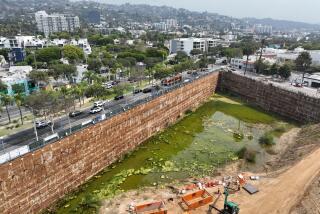Controversial site to house a school
- Share via
The Los Angeles Board of Education on Tuesday designated the field of an overcrowded east Hollywood middle school as the site of a new elementary campus, a plan that calls for building fields on a contaminated plot that the district repeatedly has passed over for previous projects.
An environmental consultant hired by the school district said the soil and underground water contamination on the site next to Virgil Middle School could be cleaned up for a “very preliminary estimate” of $10 million, which would include installation of an impermeable barrier to stop off-site pollution plumes from recontaminating the site.
The district will now begin more in-depth environmental analysis before construction begins.
“This is by no means an easy decision,” said board President Monica Garcia, who visited the school Monday. “We have looked for every piece of land, and in this mid-Wilshire area . . . density is a challenge.”
The search for a place to put the new school, known as Central Region Elementary School No. 20, has been a political minefield.
L.A. Unified district staff initially proposed expanding the site of a primary center and taking some homes that were part of the Eco Village, an environmentally friendly housing community that had once before staved off the building of a school on its site.
The group fought back again, filling public meetings and enlisting Los Angeles City Councilman Eric Garcetti to help kill the latest plan. Among their suggestions for a different location was the site across the street, at Virgil Middle School.
When Virgil teachers, parents and administrators learned about the plan recently, they applied their own political pressure.
Angry not only because of the toxics known to be on the site, the group also was concerned that the plan would create two schools separated by a fence, together housing nearly 2,000 children between ages 5 and 14 -- and that the noisy construction would make it hard for students at underperforming Virgil to improve their test scores.
Both groups spoke before the board Tuesday, as did the principal and parents of White House Place primary center, who said the board needed to quit looking and start building.
“My kids and my families have waited long enough for the construction of the new school,” said Principal Rosa Eshaq, who did not mention the pollution on the future site.
The result was an hour of public comment during which each group downplayed the concerns of the others. In the end, the board agreed to move forward with the plan at Virgil. The project could lose funding if it’s not submitted to state officials by November 2009.
The site of the future playing fields is north of the school, partially on district-owned property and also on commercial land that the district would have to buy. Environmental reports show contamination from an alphabet soup of chemicals, including benzene, ethylbenzene, toluene, vinyl chloride, MTBE, gasoline and perchloroethene, among others.
The sources of some of the underground water contamination are unknown, but at least one possible suspect is the nearby Midway Ford auto repair body shop.
If the source of the water toxics is not discovered and cleaned, it could recontaminate the water, which in turn could recontaminate the soil, according to a district consultant.
Under the current plan, the district would not just install a barrier but also dig wells outside the perimeter to monitor off-site contamination. The district must rely on regulatory agencies to compel outside businesses that are polluting the water to clean up their land, officials said.
That solution is less than satisfactory for Virgil Middle School sixth-grade math teacher Maria Magana, who appealed to the board Tuesday.
“Unless you control the sources of the contamination uphill,” she said, “there’s no sense in doing the cleanup.”
The property was considered -- and rejected -- for an elementary school in the late 1980s and a high school in the early 1990s and again as a high school in 2000, after the school board voted to cancel the half-finished Belmont Learning Complex.
--
More to Read
Sign up for Essential California
The most important California stories and recommendations in your inbox every morning.
You may occasionally receive promotional content from the Los Angeles Times.










